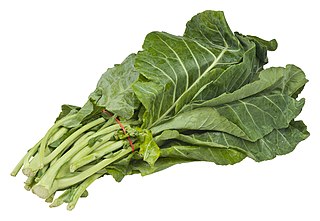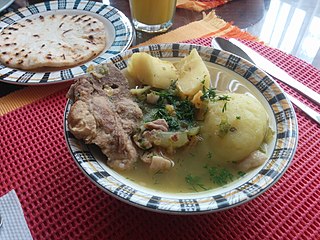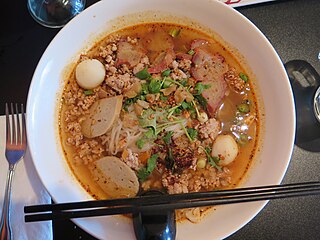
Minestrone is a thick soup of Italian origin made with meats, vegetables, and pasta. Ingredients include beans, onions, celery, carrots, leaf vegetables, stock, parmesan cheese and tomatoes.

Collard is a group of loose-leafed cultivars of Brassica oleracea, the same species as many common vegetables including cabbage and broccoli. Part of the Acephala (kale) cultivar group, it is also classified as the variety B. oleracea var. viridis.

The oldest known book on Portuguese cuisine, entitled Livro de Cozinha da Infanta D. Maria de Portugal, from the 16th century, describes many popular dishes of meat, fish, poultry and others.

Sancocho is a traditional stew in Canarian cuisine and several Latin American cuisines. Latin variations represent popular national dishes in Dominican Republic, Colombia, Cuba, Honduras, Mexico, Ecuador, Panama, Puerto Rico, Trinidad and Tobago, and Venezuela. It usually consists of large pieces of meat, tubers and vegetables served in a broth.
Soup beans is a term common in the Southern United States, particularly the regions around the Appalachian Mountains. Soup beans are usually served with cornbread, greens, and potatoes and may be topped with raw chopped onions or ramps. Soup beans are considered a main course, but also serve as a side dish. In rural areas, where food was scarce during the winter, these dried beans were a staple food.

Caldo verde is a popular soup in Portuguese cuisine.

Galician cuisine refers to the typical dishes and ingredients found in the cuisine of the autonomous community of Galicia, Spain. These include shellfish, empanadas, polbo á feira, cheese queixo de tetilla, ribeiro and albariño wines, and orujo liquor. Similarly, to Asturian cuisine, Galician dishes have maintained several Celtic links, namely with different stews.

Peranakan cuisine or Nyonya cuisine comes from the Peranakans, descendants of early Chinese migrants who settled in Penang, Malacca, Singapore and Indonesia, inter-marrying with local Malays. In Baba Malay, a female Peranakan is known as a nonya, and a male Peranakan is known as a baba. The cuisine combines Chinese, Malay, Javanese, South Indian, and other influences.

Caldo de pollo is a common Latin American soup that consists of chicken and vegetables.

Cocido or cozido is a traditional stew eaten as a main dish in Spain, Portugal, Brazil and other Hispanophone and Lusophone countries.

Puchero is a type of stew originally from Spain, prepared in Yucatán, Mexico, Argentina, Paraguay, Uruguay, Perú, south of Brazil, the Philippines, and Spain, specifically the autonomous communities of Andalusia and the Canary Islands. The Spanish word "puchero" originally meant an earthenware pot, before being extended to mean any vessel, and then the dish cooked in it.

Cabbage soup may refer to any of the variety of soups based on various cabbages, or on sauerkraut and known under different names in national cuisines. Often it is a vegetable soup, with lentils, peas or beans in place of the meat. It may be prepared with different ingredients. Vegetarian cabbage soup may use mushroom stock. Another variety is using a fish stock. There's also a preference to cook cabbage soup using a pork stock.

Gambian cuisine is part of West African cuisine and includes the culinary practices and traditions of the nation of The Gambia. Common ingredients include fish, rice, peanuts, tomato, black-eyed peas, lemon, cassava, cabbage, salt, pepper, onion, chili, and various herbs. Oysters are also a popular food from the River Gambia, and are harvested by women.

Acquacotta is a hot broth-based bread soup in Italian cuisine that was originally a peasant food. Its preparation and consumption dates back to ancient history, and it originated in the coastal area known as the Maremma, in southern Tuscany and northern Lazio. The dish was invented in part as a means to make hardened, stale bread edible. In contemporary times, ingredients can vary, and additional ingredients are sometimes used. Variations of the dish include acquacotta con funghi and acquacotta con peperoni.

Sukhothai rice noodles is a style of rice noodle soup served in Thailand. It consists of rice noodles with stock and toppings, combining rice noodle which almost served with a thin type of noodle called “sen lek”. Sliced pork or sweet pork-based broth, ground pork and crackling are almost based on the topping. Thin sliced green beans, small pieces of salted turnip, ground peanut are the main ingredients. The taste is based on sweet mellow and smell of lime, dressing with fish sauce and ground chilli. Sukhothai rice noodles are usually served on their own or with a soup.
Kadyos, baboy, kag lanka, commonly shortened to KBL, is a Filipino pork soup or stew originating from the Hiligaynon people of the Western Visayas islands. The name of the dish means "pigeon peas, pork, and jackfruit"; the three main ingredients. The soup is also traditionally soured with batuan fruits. Other souring agents like tamarind can also be used. Other ingredients include leafy greens, lemongrass, fish sauce, onions, and siling haba peppers. The pork cut used is typically the hock (pata). The dish is characteristically purple in color due to the use of pigeon peas. It is similar to another Hiligaynon dish known as kadyos, manok, kag ubad which uses chicken and banana pith instead.

















